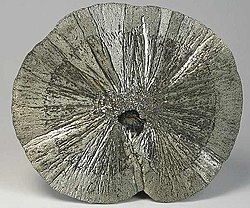Pyrite
The mineral pyrite,[1] or iron pyrite, is an iron sulfide with the formula FeS2. This mineral's metallic lustre and pale-to-normal, brass-yellow colour have earned it the nickname fool's gold because of its resemblance to gold.[2][3][4][5][6][7] The term pyrite may also be used for some other sulphides such as copper sulphide.
| Pyrite | |
|---|---|
 | |
| General | |
| Category | Sulphide mineral |
| Formula (repeating unit) | iron disulfide (FeS2) |
| Identification | |
| Color | Pale brass-yellow, tarnishes darker and iridescent |
| Crystal habit | Cubic |
| Crystal system | Isometric Diploidal, Space group Pa3 |
| Mohs scale hardness | 6–6.5 |
| Luster | Metallic, glistening |
| Streak | Greenish-black to brownish-black; smells of sulphur |
| Specific gravity | 4.95–5.10 |
| Solubility | Insoluble in water |
| Other characteristics | paramagnetic |
Uses
In the 16th and 17th centuries, pyrite was used to create sparks in early firearms called wheellocks. The Kaurna people of South Australia also used pyrite with flintstone and bark to start fires in their traditional way.[8][9]
Since ancient times, pyrite helped make copperas (ferrous sulfate) by letting it weather in big heaps. By the 19th century, this method replaced burning sulfur to produce sulfuric acid. Even today, pyrite is used to make sulfur dioxide for the paper industry and to manufacture sulfuric acid. Heating pyrite also gives iron sulfide (FeS) and elemental sulfur.[10][11]
In modern times, pyrite has new uses. It works as the cathode material in some Energizer lithium batteries. Pyrite is also a natural semiconductor with a band gap of 0.95 eV and is naturally n-type because of tiny sulfur gaps in its structure.[12][13][14]
In the early 1900s, pyrite was used in crystal radios as a detector. Some hobbyists still use it today, and it can work as well as modern germanium diodes.[15]
History
Pyrite is the most common sulphide mineral. In ancient Roman times, the name was applied to several types of stone that would create sparks when it was struck against steel. Pliny the Elder described one of them as being brassy, which was almost certainly a reference to what is now called pyrite.[16]
By Georgius Agricola's time, the term had become a generic term for all sulphide minerals.[17]
Pyrite is usually found associated with other sulphides or oxides in quartz veins, sedimentary rock, and metamorphic rock, as well as in coal beds and as a replacement mineral in fossils. Despite being nicknamed fool's gold, pyrite is sometimes found in association with small amounts of gold.
Gallery
Ammonite with Pyrite
Pyrite Media
Pyrite from the Sweet Home Mine, with golden striated cubes intergrown with minor tetrahedrite, on a bed of transparent quartz needles
References
- ↑ The name pyrite is derived from the Greek πυρίτης (puritēs), "of fire" or "in fire", from πύρ (pur), "fire".
- ↑ Julia A. Jackson, James Mehl and Klaus Neuendorf, Glossary of Geology, American Geological Institute (2005) p82.
- ↑ Albert H. Fay, A glossary of the mining and mineral industry, United States Bureau of Mines (1920) pp. 103–104.
- ↑ Hurlbut, Cornelius S.; Klein, Cornelis 1985. Manual of Mineralogy. 20th ed, John Wiley and Sons, New York. 285–286 ISBN 0-471-80580-7
- ↑ Pyrite on webmineral
- ↑ Pyrite on Mindat.org
- ↑ Handbook of Mineralogy
- ↑ "Firearms - Document - Gale eBooks". go.gale.com. Retrieved 2025-07-30.
- ↑ "Wayback Machine" (PDF). www.adelaide.edu.au. Retrieved 2025-07-30.
- ↑ Wood, Henry Trueman (1910). Industrial England in the middle of the eighteenth century. University of California Libraries. London : J. Murray.
- ↑ Rosenqvist, Terkel (2004). Principles of Extractive Metallurgy. Tapir Academic Press. ISBN 978-82-519-1922-7.
- ↑ "Wayback Machine" (PDF). data.energizer.com. Archived from the original (PDF) on 2006-03-17. Retrieved 2025-07-30.
- ↑ "20 Pyrite Stone Benefits in Hindi | पाइराइट पत्थर के फायदे, उपयोग, कैसे पहनें | Pyrite Stone in Hindi". 2025-07-28. Retrieved 2025-07-30.
- ↑ "Iron Disulfide (Pyrite) as Photovoltaic Material". www.esqsec.unibe.ch. Archived from the original on 2010-01-15. Retrieved 2025-07-30.
- ↑ Zhang, Xin; Li, Mengqun; Walter, Jeff; O’Brien, Liam; Manno, Michael A.; Voigt, Bryan; Mork, Frazier; Baryshev, Sergey V.; Kakalios, James; Aydil, Eray S.; Leighton, Chris (2017-06-19). "Potential resolution to the doping puzzle in iron pyrite: Carrier type determination by Hall effect and thermopower". Physical Review Materials. 1 (1): 015402. doi:10.1103/PhysRevMaterials.1.015402.
- ↑ James Dwight Dana, Edward Salisbury Dana, Descriptive Minerology, 6th ed., Wiley, New York (1911) p86.
- ↑ Herbert Clark Hoover and Lou Henry Hoover, translators of Georgius Agricola, [De Re Metallica], The Mining Magazine, London (1912; Dover reprint, 1950); see footnote, p. 112.









